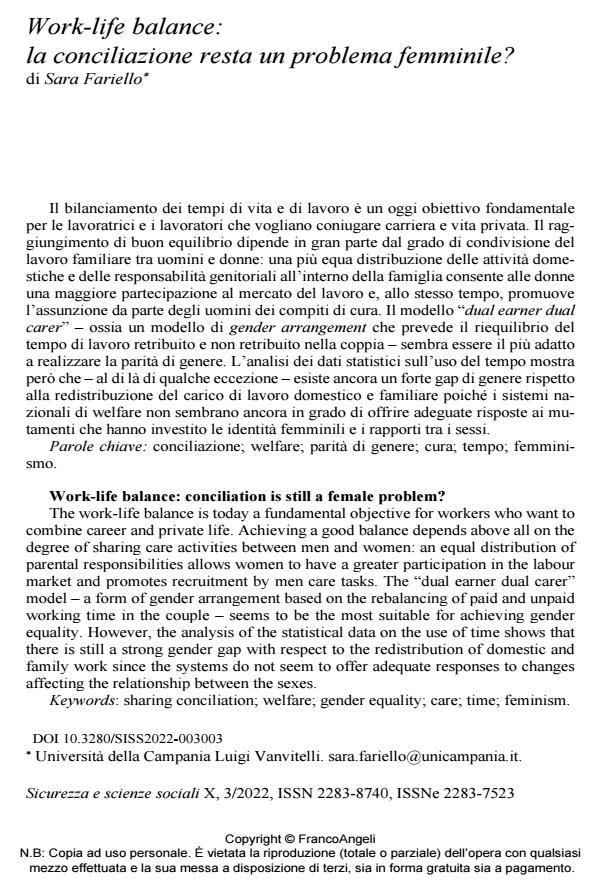Work-life balance: la conciliazione resta un problema femminile?
Titolo Rivista SICUREZZA E SCIENZE SOCIALI
Autori/Curatori Sara Fariello
Anno di pubblicazione 2022 Fascicolo 2022/3
Lingua Italiano Numero pagine 24 P. 27-50 Dimensione file 262 KB
DOI 10.3280/SISS2022-003003
Il DOI è il codice a barre della proprietà intellettuale: per saperne di più
clicca qui
Qui sotto puoi vedere in anteprima la prima pagina di questo articolo.
Se questo articolo ti interessa, lo puoi acquistare (e scaricare in formato pdf) seguendo le facili indicazioni per acquistare il download credit. Acquista Download Credits per scaricare questo Articolo in formato PDF

FrancoAngeli è membro della Publishers International Linking Association, Inc (PILA)associazione indipendente e non profit per facilitare (attraverso i servizi tecnologici implementati da CrossRef.org) l’accesso degli studiosi ai contenuti digitali nelle pubblicazioni professionali e scientifiche
Il bilanciamento dei tempi di vita e di lavoro è un oggi obiettivo fondamentale per le lavoratrici e i lavoratori che vogliano coniugare carriera e vita privata. Il rag-giungimento di buon equilibrio dipende in gran parte dal grado di condivisione del lavoro familiare tra uomini e donne: una più equa distribuzione delle attività do-mestiche e delle responsabilità genitoriali all’interno della famiglia consente alle donne una maggiore partecipazione al mercato del lavoro e, allo stesso tempo, promuove l’assunzione da parte degli uomini dei compiti di cura. Il modello "dual earner dual carer" - ossia un modello di gender arrangement che prevede il riequilibrio del tempo di lavoro retribuito e non retribuito nella coppia - sembra essere il più adatto a realizzare la parità di genere. L’analisi dei dati statistici sull’uso del tempo mostra però che - al di là di qualche eccezione - esiste ancora un forte gap di genere rispetto alla redistribuzione del carico di lavoro domestico e familiare poiché i sistemi nazionali di welfare non sembrano ancora in grado di offrire adeguate risposte ai mutamenti che hanno investito le identità femminili e i rapporti tra i sessi.;
Keywords:conciliazione; welfare; parità di genere; cura; tempo; femminismo.
- AA.VV. (2008). Lavoro e maternità. Il doppio sì. Esperienze e innovazioni, Quaderni di via Dogana, Liberia delle donne di Milano.
- Badinter E. (2011). Mamme cattivissime? Milano: Corbaccio.
- Badinter E. (1993). L’amore in più. Storia dell’amore materno. Milano: Tea.
- Butler J. (2014). Fare e disfare il genere. Milano: Mimesis.
- Beck U. (2000). La società del rischio. Verso una seconda modernità. Roma: Carocci.
- Chororow N. (1991). La funzione materna: psicoanalisi e sociologia del ruolo materno. Milano: la Tartaruga.
- Crompton R. (1999). Restructuring Gender Relations and Employment: The Decline of the Male Breadwinner. Oxford: Oxford University Press.
- De Beauvoir S. (1999). Il secondo sesso. Milano: il Saggiatore.
- Esping-Andersen G. (2009). Incomplete Revolution: Adapting Welfare State to Women’s New Role. Cambridge: Polity Press.
- Fariello S., Strazzeri I., De Sanctis D. (2020). Sociologia della maternità. Milano: Mimesis.
- Firestone S. (1971). La dialettica dei sessi. Autoritarismo maschile e società tardo-capitalistica. Bologna: Guardaldi editore.
- Fraser N. (1994). After the Family Wage, Political Theory, 22, 591-618.
- Fuochi G., Mecarini L., Solera C. (2014). I padri coinvolti e i mariti egalitari: per scelta o per vincoli? Uno sguardo alle coppie italiane con figli piccoli. AboutGender, 3 (6), 54-86.
- Gaiaschi C. (2014). Oltre il modello dual earner – dual carer: dalla conciliazione condivisa per tutt* alla conciliazione fra tutt*. AboutGender, 3 (6), 1-24.
- Giddens A. (1994). Le conseguenze della modernità. Bologna: il Mulino.
- Gilligan C. (1991). Con voce di donna. Etica e formazione della personalità. Milano: Feltrinelli.
- Gornick J. C., Meyers M. K. (2003). Families that Work: Policies For Reconciling Parethood And Employment. New York: Russel Sage Foundattion.
- Hochschild A. R., Machung A. (1989). The Second Schift: Working Parets and Revolution at Home. New York: Viking Penguin.
- ISTAT (2019). I tempi della vita quotidiana. Lavoro, conciliazione, parità di genere e benessere soggettivo. Roma: Istituto Nazionale di Statistica.
- Magaraggia S. (2013). Di certo mio figlio non lo educo come dei miei. Relazioni intergenerazionali e trasformazione dei desideri paterni. Studi Culturali, 10 (2), 189-220.
- Orloff A. (1996). Gender in the Welfare State. Annual Review of Sociology, 22, 51-78.
- Ruspini E. (2017). Le identità di genere. Roma: Carocci.
- Saraceno C., Naldini M. (2007). Sociologia della famiglia. Bologna: il Mulino.
- Saraceno C., Keck, W. (2011). Towards an Integration Approach for the Analysis of Gender Equality in Policies Supporting Paid Work and Care Responsibilities. Demographic Research, 25 (11), 371-406.
- Saraceno C. (2017). L’equivoco della famiglia. Bari-Roma: Laterza.
- Saraceno C. (2013). Il Welfare. Modelli e dilemmi della cittadinanza sociale. Bologna: il Mulino.
- Zanatta A.L. (2011). Nuove madri e nuovi padri. Essere genitori oggi. Bologna: il Mulino.
Sara Fariello, Work-life balance: la conciliazione resta un problema femminile? in "SICUREZZA E SCIENZE SOCIALI" 3/2022, pp 27-50, DOI: 10.3280/SISS2022-003003